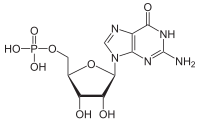Guanosine monophosphate
This article needs additional citations for verification. (April 2010) |

| |

| |
| Names | |
|---|---|
| Preferred IUPAC name
[(2R,3S,4R,5R)-5-(2-Amino-6-oxo-1,6-dihydro-9H-purin-9-yl)-3,4-dihydroxyoxolan-2-yl]methyl dihydrogen phosphate | |
| Other names | |
| Identifiers | |
3D model (JSmol)
|
|
| Abbreviations | GMP |
| ChEMBL | |
| ChemSpider | |
| ECHA InfoCard | 100.001.453 |
| E number | E626 (flavour enhancer) |
IUPHAR/BPS
|
|
| MeSH | Guanosine+monophosphate |
PubChem CID
|
|
| UNII | |
CompTox Dashboard (EPA)
|
|
| |
| Properties | |
| C10H14N5O8P | |
| Molar mass | 363.223 g·mol−1 |
| Acidity (pKa) | 0.7, 2.4, 6.1, 9.4 |
Except where otherwise noted, data are given for materials in their standard state (at 25 °C [77 °F], 100 kPa). | |
| Infobox references | |
Guanosine monophosphate (GMP), also known as 5′-guanidylic acid or guanylic acid (conjugate base guanylate), is a nucleotide that is used as a monomer in RNA. It is an ester of phosphoric acid with the nucleoside guanosine. GMP consists of the phosphate group, the pentose sugar ribose, and the nucleobase guanine; hence it is a ribonucleoside monophosphate. Guanosine monophosphate is commercially produced by microbial fermentation.[1]
As an acyl substituent, it takes the form of the prefix guanylyl-.
De novo synthesis[]
GMP synthesis starts with D-ribose 5′-phosphate, a product of the pentose phosphate pathway. The synthesis proceeds by the gradual formation of the purine ring on carbon-1 of ribose, with CO2, glutamine, glycine, aspartate and one-carbon derivatives of tetrahydrofolate donating various elements towards the building of the ring[2]

As inhibitor of guanosine monophosphate synthesis in experimental models, the glutamine analogue DON can be used.[3]
cGMP[]
GMP can also exist as a cyclic structure known as cyclic GMP. Within certain cells the enzyme guanylyl cyclase makes cGMP from GTP.
cGMP plays an important role in mediating hormonal signaling.[2]
Food additive[]
Guanosine monophosphate is known as E number reference E626.[4] In the form of its salts, such as disodium guanylate (E627), dipotassium guanylate (E628) and calcium guanylate (E629), are food additives used as flavor enhancers to provide the umami taste.[4] It is often used in synergy with disodium inosinate; the combination is known as disodium 5′-ribonucleotides. Disodium guanylate is often found in instant noodles, potato chips and snacks, savoury rice, tinned vegetables, cured meats, and packet soup.
As it is a fairly expensive additive, it is usually not used independently of glutamic acid or monosodium glutamate (MSG), which also contribute umami. If inosinate and guanylate salts are present in a list of ingredients but MSG does not appear to be, the glutamic acid is likely provided as part of another ingredient, such as a processed soy protein complex (hydrolyzed soy protein), autolyzed yeast, or soy sauce.
See also[]
- Acceptable daily intake
- Disodium guanylate
- Disodium inosinate
- Inosinic acid
- Glutamate flavoring
- Kikunae Ikeda
- Umami
- Ajinomoto
- Tien Chu Ve-Tsin
- Glutamic acid
- Disodium glutamate
- Monopotassium glutamate
- Adenosine monophosphate
- Hypoxanthine-guanine phosphoribosyltransferase
- Ribonucleoside
References[]
- ^ "The Vegetarian Resource Group Blog". www.vrg.org. Retrieved 25 April 2018.
- ^ a b Voet, Donald; Voet, Judith G. (2012). Biochemistry. USA: John Wiley & Sons Inc. pp. 1107–1109. ISBN 978-0-470-57095-1.
- ^ Ahluwalia GS et al. Metabolism and action of amino acid analog anti-cancer agents ”, in Pharmac. Ther. (1990) 46: 243-271
- ^ a b "Additive categories | CEFF". www.ceff.info. Retrieved 2021-11-30.
- Nucleotides
- Flavor enhancers
- Phosphate esters
- Purines
- E-number additives